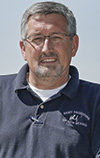February is not your typical “discuss silage safety month.” However, in light of recent silage-related injuries and fatalities with pile management, this month’s safety article is focused on hazards associated with managing silage in bunker silos and drive-over piles. Silage injury or fatality statistics are not easily collected; however, silage-related fatalities continue to be reported in local media outlets.
For example, recently a 34-year-old male was killed when he was working in a bunker silo on a southwestern U.S. dairy farm. A silage avalanche that weighed 10-15 tons fell on him. Fellow workers found his truck still running, but the worker was nowhere to be found. A local sheriff’s deputy was quoted in the paper that the depth of the silage was about 20 feet high.
There are six hazards that dairy owners, managers and employees need to be aware of when working around bunker silos and drive-over piles: tractor roll-overs, entanglement or run-over by machinery, falls from heights, avalanche or collapsing silage, nitrogen dioxide, and worker fatigue and complacency.
Tractor roll-overs
Tractor roll-overs are the leading cause of fatalities on U.S. farms. Steep inclines and straight drop-offs from silo walls are significant risks for tractor overturns. Tractors should be equipped with roll-over protective structures (ROPS), which create a zone of protection around the tractor operator. Operators should also use seat belts at all times.
ROPS and seat belts prevent the operator from being thrown from the tractor and being crushed. Bunker silos should never be filled higher than the top of the wall. Lighting and rails should be installed above the walls to indicate the location of the wall.
To reduce the risk of a tractor roll-over, it is very important to maintain a maximum slope of 1 to 3 on the sides and ends of a drive-over pile. Lastly, tractors should be backed up steep slopes to prevent the tractor from tipping backward.
Machinery entanglement or run-overs
Workers and farm visitors should not be in the vicinity of silage machinery. Machine guards and shields should be kept in place to protect the operator from an assortment of rotating shafts, chain and v-belt drives, gears and pulleys and rotating knives on forage harvesters, wagons and silage feeding equipment. Children should never be allowed in the vicinity of a bunker or pile.
Falls from heights
Working on top of bunker silos and silage piles creates a risk for falls. Workers can easily slip on plastic when covering or uncovering a bunker or pile, especially in wet weather. Guardrails should be installed on all above ground level walls. Fall protection should also be employed if necessary. Workers should never be allowed to ride in the bucket of a front end loader when accessing the top of a bunker or pile.
Avalanche or collapsing silage
A major contributory factor to injury or fatality from silage avalanche/collapse is over-filled bunker silos and drive over piles. Bunkers and piles should never be filled higher than the unloading equipment can reach safely. Proper unloading techniques include shaving silage down the feed out face, and never “dig” the bucket into the bottom of the silage.
Undercutting, a situation that is quite common when the unloader bucket cannot reach the top of an over-filled bunker or pile, creates an overhang of silage that can loosen and tumble to the floor. Never allow people to stand near the feed out face, and a rule of thumb is never stand closer to the feeding face than three times its height.
When sampling silage, take samples from a pile of silage in the commodity barn, as it has been removed from the silage pile or bunker. The perimeter of bunker silos and drive-over piles should be roped off or fenced with proper warning signs posted.
Nitrogen dioxide
Numerous gases including carbon dioxide and nitric oxide are produced during the first two to three weeks of the harvesting, filling and ensiling periods. Nitric oxide changes to nitrogen dioxide when it contacts oxygen in the air. Nitrogen dioxide (NO2) is a toxic gas, and it can produce sudden death. The highest levels of nitrogen dioxide are usually present during the first 24 to 72 hours after the forage is put into the silo, but dangerous levels can persist for up to three weeks.
When inhaled, NO2 dissolves in the moisture on the internal lung surfaces to form nitric acid. This strong acid burns the pulmonary membrane tissue, effectively stopping the supply of oxygen to the body. Depending on the NO2 concentration, the presence of this “silo gas” might be recognized by a burning sensation in the nose, throat and chest.
Pulmonary edema and lower airway obstruction may not become apparent until several weeks after exposure and initial recovery symptoms and individuals who survive acute exposures should be closely followed by their physician. Prevention includes adequate ventilation and proper respiratory protection.
Worker complacency
All workers should always pay attention to their surroundings and stay alert, especially during night shifts when worker fatigue is a common reality. Proper lighting is important on night shifts.
Conclusions
Silage-related fatalities and injuries are preventable. All workers and service personnel should receive proper training and education regarding silage safety. Machinery operators should be properly trained and their performance evaluated on a regular basis in every silage program.
All workers should be educated on the risks associated with bunker silos and drive-over piles, and a good time to do this might be in preparation of silage season in the fall. Proper bunker silo and drive-over pile management can significantly reduce the risk for worker fatality or injury. PD
Keith Bolsen is professor emeritus from Kansas State University.
Steve Reynolds is a professor at Colorado State University and director of the High Plains and Intermountain Center for Agricultural Health and Safety.
Dr. Robert Hagevoort teaches at New Mexico State University, Dairy Extension.
Dr. David Douphrate is an assistant professor at the University of Texas, School of Public Health. He conducts research and outreach related to worker health and safety through the High Plains and Intermountain Center for Agricultural Health and Safety (HICAHS), headquartered at Colorado State University.







